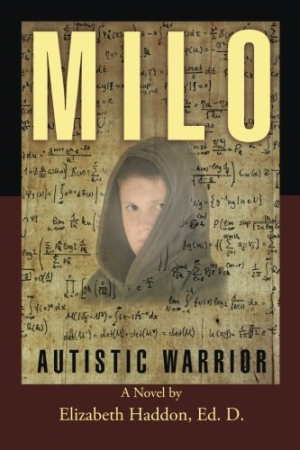Milo
Autistic Warrior
A poignant presentation of autism and its effects on a family.
ABC’s hit show Parenthood has brought Asperger’s syndrome and its effects on a family to the fore. Now comes Elizabeth Haddon’s book, Milo: Autistic Warrior, about how a young man’s Asperger’s affects him, his family, and his school community. The novel poignantly explores the themes of family dynamics, how the diagnosis affects people, and different forms of love.
Milo, smart and obsessed with math and science, is neglected by his parents, Arthur and Winnie, until age eleven. Arthur says, “The doctor told us … not to have any expectations he’ll develop into anything. We taught him to stay quiet and out of the way.” Winnie takes the medical professional’s advice to heart, persisting in these attitudes, even as Arthur realizes the scope of his son’s intellect as a result of a chance conversation about Roman history. As mutual love and understanding grow between the pair, facilitated in part by Milo’s history teacher and a family therapist, father and son become “warriors … connected as allies.”
The book accurately depicts behaviors common among people with Asperger’s, such as a dislike of touch, very literal answers to questions, and the inability to read social cues. Told in limited third-person omniscient narration, the book masterfully captures Milo’s confusion and fear as he navigates his mainstream school setting and his tenuous relationship with Winnie. Similarly, the text also captures the breadth of Arthur’s awe and affection as he realizes his son’s talents. Winnie, however, dislikes the change in the boy, blaming him for her violent outbursts and increased marital tension. Winnie ultimately loses the battle, becoming, in one of the book’s many lovely metaphors, “like a faded, torn flower long forgotten in a child’s flower press.”
With Winnie out of the picture, the “warriors” soldier on through Milo’s sixth-grade year, navigating bullying, social skills classes, and Milo’s increasing self-awareness. Although Milo and his family members are multifaceted, other characters are one-dimensional; the all-knowing psychotherapist constantly says the right thing, and the cold math teacher prevents Milo from leaving her math class for a higher level, even after he aces the placement test. Also, change in the school occurs too fast; it only takes one parent meeting and the enactment of one strategy to decrease bullying on the buses.
In the book’s final third, the plot derails, becoming a different story entirely. Suddenly Milo is now twenty, and the author presents new characters and a bizarre eugenics movement of sorts. The only warning of this abrupt shift is a page between the two sections, reading “Eight Years Later—Milo is Twenty Years Old.” Past this point, the chapters have headings like that of a journal: “Day 1 Thursday.”
After spending the majority of the book portraying Milo as preteen whom one comes to care for, and to wonder, as Arthur does, how this unique kid will navigate adolescence, the book skips over this tumultuous phase without a blink. No longer does Milo have to navigate realistic dangers, but instead something better suited to a futuristic dystopian plot: a cadre of people that seeks to destroy the students with autism in Milo’s school.
The first sections present a thought-provoking novel for those learning about autism.
Reviewed by
Jill Allen
Disclosure: This article is not an endorsement, but a review. The publisher of this book provided free copies of the book and paid a small fee to have their book reviewed by a professional reviewer. Foreword Reviews and Clarion Reviews make no guarantee that the publisher will receive a positive review. Foreword Magazine, Inc. is disclosing this in accordance with the Federal Trade Commission’s 16 CFR, Part 255.


